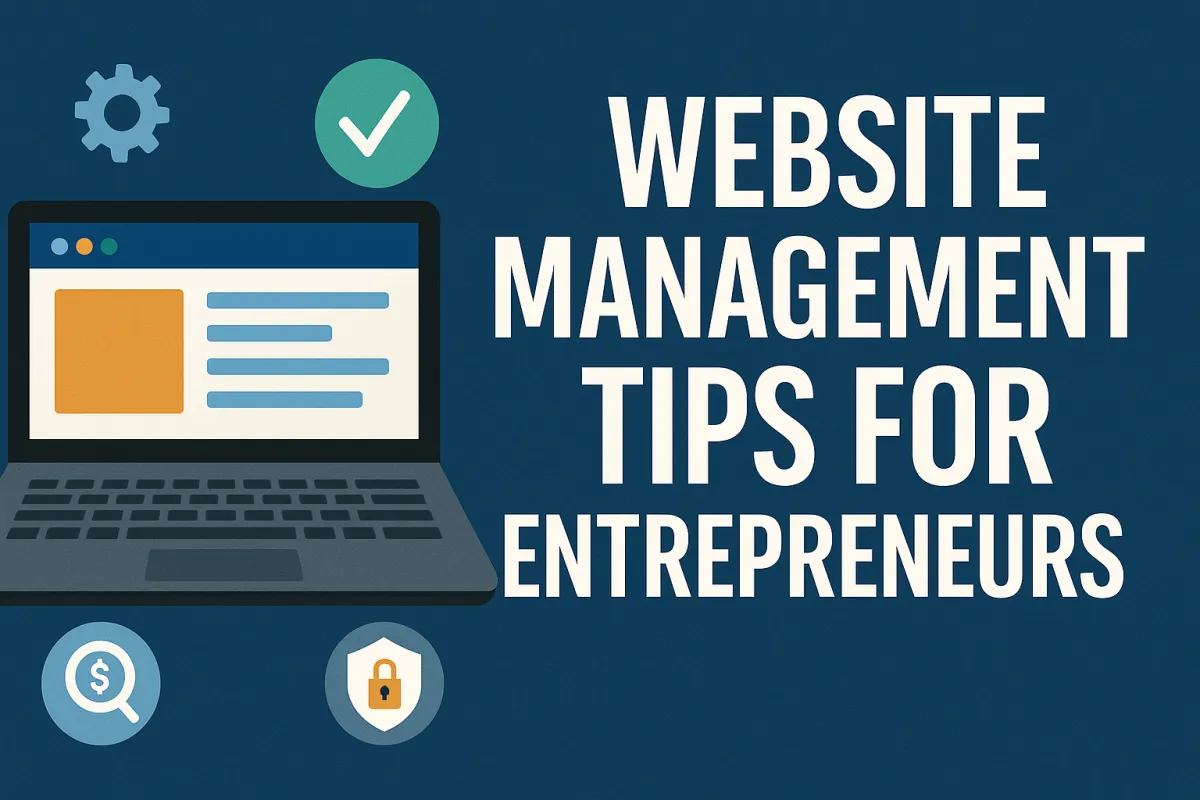
Essential Website Management Tips for Entrepreneurs
Website Management Tips for Entrepreneurs: Build, Optimize, and Grow in 2025
SEO Title:
Website Management Tips for Entrepreneurs: Boost Security, SEO & Sales in 2025
Meta Description:
Discover powerful website management strategies every entrepreneur needs in 2025. Learn how to improve site speed, content, SEO, and security to grow traffic and conversions.
Introduction: Your Website Is Your Business Lifeline
Did you know that 88% of online consumers are less likely to return to a website after a bad experience? In today’s fast-paced digital economy, your website is more than a digital brochure—it’s the beating heart of your business. It serves as your 24/7 sales representative, customer service hub, and brand ambassador.
Whether you're building a startup or scaling your brand, mastering website management isn’t a luxury—it’s a competitive requirement. A poorly managed website costs you traffic, trust, and revenue. A well-managed one builds authority, improves visibility, and fuels conversions.
This guide equips modern entrepreneurs with practical, actionable strategies to manage and scale their websites successfully in 2025 and beyond.
Understanding Website Management: What It Really Means
Website management is the continuous process of maintaining, optimizing, and updating your website to ensure it remains fast, secure, functional, and aligned with your business goals.
Core Aspects of Website Management:
Technical maintenance: Hosting, domain, speed, and performance
Content operations: Blog publishing, media updates, and on-page copy improvements
Security auditing: SSL setup, firewalls, malware scans
Analytics and reporting: Using Google Analytics, Search Console, and heatmaps
UX design and layout: Keeping your site user-friendly across all devices
Websites today are dynamic ecosystems, not static pages. Managing yours effectively means building long-term value while reducing downtime and missed opportunities.
Why Website Management Matters More Than Ever
As competition heats up and digital expectations rise, business owners need to offer seamless online experiences or risk losing customers.
Faster websites convert better: A 1-second delay in load time can reduce conversions by 7%.
Google rewards managed sites: SEO rankings are influenced by site speed, mobile-friendliness, and content freshness.
Cybersecurity is non-negotiable: Hackers target outdated and unprotected sites, especially small businesses.
Why Entrepreneurs Must Prioritize Website Management
1. More Leads, More Conversions
Optimized websites help users find answers, sign up, or buy quickly. A streamlined UX and frequent A/B testing help convert more visitors into paying customers.
2. Protects Brand and User Data
With rising cyberattacks, protecting your site with SSL, malware scanners, and secure backups is key to customer trust.
3. Boosts Search Engine Rankings
Sites that load quickly, stay updated, and feature mobile-friendly designs rank better—leading to more organic traffic and long-term visibility.
4. Builds Long-Term Brand Authority
Regular content updates, testimonials, and trust badges all improve your brand reputation and digital footprint.
Actionable Strategies to Master Website Management
1. Routine Maintenance and Technical Hygiene
Update Plugins and Themes Weekly: Avoid security vulnerabilities by staying current.
Automate Website Backups: Use cloud storage or plugins to back up your site regularly.
Test Speed and Uptime: Use tools like Google PageSpeed Insights, Pingdom, and Cloudflare.
2. Content Management and Organization
Create Value-Driven Blog Content: Focus on educational, SEO-friendly posts.
Maintain a Content Calendar: Plan using tools like ClickUp or Notion.
Optimize Existing Content: Refresh CTAs, keywords, and outdated media quarterly.
3. SEO and UX Optimization
Use Correct Header Tag Hierarchy (H1-H3): Helps structure your content for search engines.
Optimize Images and Use Caching: Speeds up your site significantly.
Ensure Mobile Compatibility: Over 60% of traffic is mobile—design accordingly.
4. Enhance Layout, Visuals, and CTAs
Use Strategic Visuals: Showcase your brand through professional, compressed imagery.
Craft Compelling CTAs: Use action words that trigger urgency and value (e.g., "Download My Free Guide").
Simplify Navigation: Ensure visitors can find what they need in two clicks or less.
5. Leverage Social Proof and Success Stories
Add Reviews and Ratings: Pull reviews from Google Business Profile.
Highlight Testimonials and Case Studies: Showcase real-world outcomes for credibility.
Common Mistakes Entrepreneurs Should Avoid
1. Neglecting Website Speed
Speed influences both bounce rate and SEO. Use caching, compress images, and streamline code.
2. Skipping Security Updates
Failing to update your CMS or plugins leaves your site vulnerable. Automate updates if needed.
3. Lack of Backups
Not backing up your website regularly can lead to total data loss. Use plugins or host-side options.
4. Inconsistent Branding
Fonts, colors, and design styles should be consistent across all pages to maintain trust.
5. Forgetting Mobile Optimization
A desktop-only site frustrates mobile users. Responsive design is a must in 2025.
Getting Started: A Simple Roadmap for Entrepreneurs
Step 1: Conduct a Full Website Audit
Use Google Search Console and PageSpeed Insights to diagnose issues.
Step 2: Organize a Management Workflow
Assign roles and tasks via Notion or ClickUp for content, security, and updates.
Step 3: Install Critical Tools
SSL Certificate
Google Analytics + Search Console
Cloudflare for CDN and DDoS protection
Backup plugin (UpdraftPlus or host-integrated)
Step 4: Set Monthly Optimization Goals
Review and improve one key area per month (content, SEO, speed, security, design).
Step 5: Track Performance Consistently
Use dashboards to monitor KPIs like bounce rate, load time, conversion rate, and SEO rankings.
Conclusion: Website Management Is Business Management
A powerful online presence starts with consistent website management. Whether you're running a one-person operation or leading a growing team, your website should work for your business—not against it.
With the right tools, habits, and strategies, you can transform your website into a high-performing, lead-generating, brand-enhancing machine in 2025 and beyond.
